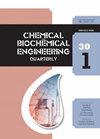颗粒氧化铁吸附去除水溶液中五价砷
IF 0.9
4区 生物学
Q4 BIOTECHNOLOGY & APPLIED MICROBIOLOGY
引用次数: 0
摘要
水资源中的砷污染是一个全球性问题,其特点是具有强烈的致癌和毒性影响。因此,本研究的重点是对初始浓度为1000µg L−1的五价砷As(V)从水溶液中吸附到颗粒状氧化铁(GFO)上的等温线和动力学研究。采用分批法进行吸附实验,并采用Langmuir、Freundlich、Dubinin-Radushkevich、Redlich-Peterson和Sips等温线模型以及拟一阶和拟二阶动力学模型对平衡和动力学数据进行了评价。研究结果表明,As(V)在GFO上的吸附是一个有利的、物理的、多层的过程。根据相关系数的值,Sips和Redlich-Peterson等温线以及伪一阶动力学模型对实验数据的拟合最好。Langmuir等温线模型的最大理论吸附容量为1900µg g−1。此外,还研究了as(V)初始浓度、吸附剂用量、搅拌速度、pH、温度以及磷酸盐和二氧化硅的存在等不同操作条件对GFO吸附能力的影响。在三个吸附-解吸循环期间,通过0.1M NaOH解吸溶液从GFO中有效地回收As(V)。本文章由计算机程序翻译,如有差异,请以英文原文为准。
Adsorptive Removal of Pentavalent Arsenic from Aqueous Solutions by Granular Ferric Oxide
Arsenic contamination of water resources, which is characterized by strong carcino-genic and toxic impacts, is a global problem. Therefore, the present study is focused on the isotherm and kinetic studies of pentavalent arsenic As(V) adsorption with initial concentration of 1 000 µg L −1 from aqueous solutions onto granular ferric oxide (GFO). Adsorption experiments were carried out by batch method, and the equilibrium and kinetic data were evaluated by the Langmuir, Freundlich, Dubinin-Radushkevich, Redlich-Peterson and Sips isotherm model, and pseudo-first and pseudo-second order kinetic model. The results obtained from this study imply that the adsorption of As(V) onto GFO was favourable, physical and multilayer process. The Sips and Redlich-Peter-son isotherm and the pseudo-first order kinetic model gave the best fit to experimental data according to the values of correlation coefficient. The maximum theoretical adsorption capacity from Langmuir isotherm model was determined to be 1 900 µg g −1 . In ad-dition, the impact of different operating conditions such as As(V) initial concentration, adsorbent dose, agitation speed, pH, temperature, and presence of phosphates and silica on adsorption capacity of GFO was also investigated. As(V) was efficiently recovered from GFO by 0.1 M NaOH desorbing solution during the three adsorption-desorption cycles.
求助全文
通过发布文献求助,成功后即可免费获取论文全文。
去求助
来源期刊
CiteScore
2.70
自引率
6.70%
发文量
23
审稿时长
>12 weeks
期刊介绍:
The journal provides an international forum for presentation of original papers, reviews and discussions on the latest developments in chemical and biochemical engineering. The scope of the journal is wide and no limitation except relevance to chemical and biochemical engineering is required.
The criteria for the acceptance of papers are originality, quality of work and clarity of style. All papers are subject to reviewing by at least two international experts (blind peer review).
The language of the journal is English. Final versions of the manuscripts are subject to metric (SI units and IUPAC recommendations) and English language reviewing.
Editor and Editorial board make the final decision about acceptance of a manuscript.
Page charges are excluded.

 求助内容:
求助内容: 应助结果提醒方式:
应助结果提醒方式:


